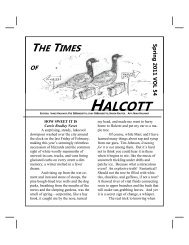vol 47 summer 2009 - Town of Halcott, Halcott Center, NY
vol 47 summer 2009 - Town of Halcott, Halcott Center, NY
vol 47 summer 2009 - Town of Halcott, Halcott Center, NY
You also want an ePaper? Increase the reach of your titles
YUMPU automatically turns print PDFs into web optimized ePapers that Google loves.
need. And that’s good, because here in our valley,<br />
the season is shorter than <strong>NY</strong>C (where I kept bees<br />
for about 7 years). The winter is longer and<br />
colder, so their proximity to good forage is an<br />
advantage. Last year, some <strong>of</strong> our neighbors reported<br />
better than average apple yields, saying<br />
they saw more bees in their orchards and gardens<br />
than ever before. I can’t be sure whether the bees<br />
they saw were my bees or feral colonies living in<br />
the forest, but I’ll take credit if it’s thrust on me!<br />
Honey bees were first brought to the US by early<br />
colonists, and have been escaping into the forests<br />
ever since. Knowing that Virgil Streeter kept bees<br />
here in <strong>Halcott</strong> for years makes me think that there<br />
must be many escaped, naturalized, feral colonies<br />
in our woods.<br />
Bees expand into new geographic locations<br />
by swarming. As a colony builds up its numbers<br />
in the spring, a vigilant beekeeper will add<br />
hive boxes to give them more space, or the bees,<br />
feeling the squeeze, will naturally divide the hive<br />
by swarming. As a swarm becomes imminent,<br />
they build a special peanut-shaped cell<br />
and move a newly-laid egg into a royal jelly<br />
-rich environment to create a new queen.<br />
The special care and diet this larvae receives<br />
triggers genetic switches that make<br />
her grow larger than all the other bees, with functional<br />
ovaries for breeding. When she emerges as<br />
an adult bee, the virgin queen will fly away with<br />
several thousand workers to find a new home. It’s<br />
a fascinating thing to watch so many bees in the<br />
air at once. The sound is incredible, and it’s remarkable<br />
how tame they can be. They typically<br />
engorge themselves with honey prior to this expedition,<br />
and the “stuffed” feeling <strong>of</strong> a belly full <strong>of</strong><br />
honey makes them less aggressive. Plus, at that<br />
moment, they don’t have a home to defend. They<br />
<strong>of</strong>ten congregate on a branch and wait for scout<br />
bees to find a suitable hollow tree or other space<br />
to set up the new home. Once a spot is found, and<br />
a consensus is reached, they move en masse to the<br />
new location and settle in, building new comb and<br />
gathering nectar and pollen for brood rearing. The<br />
queen doesn’t necessarily direct the swarm, but<br />
her presence is essential to the survival <strong>of</strong> the new<br />
2<br />
colony.<br />
From time to time, feral bees are reported<br />
to crash from diseases as well. It’s hard to know<br />
for sure. Recently, I’ve heard from beekeepers<br />
around the country that feral colonies are booming<br />
once again. And that’s encouraging, because they<br />
represent a treasure trove <strong>of</strong> valuable genetics that<br />
beekeepers can incorporate into managed colonies,<br />
especially at a time when breeding may be<br />
the best way to fight CCD. Virgin queens make<br />
one crucial flight to mate with several drones before<br />
settling in to lay up to 1500 eggs a day. Feral<br />
bees are generally well-adapted to their local environment,<br />
and may have other desirable traits –<br />
disease resistance in an unmanaged state for one. I<br />
recently made “splits” <strong>of</strong> my hives, simulating a<br />
swarm by taking a few frames from each hive and<br />
separating them into “nuc” boxes. If all goes well,<br />
the bees will make a new queen for each split, and<br />
my new hives will thrive. The virgin queen in<br />
these new colonies will mate with drones in our<br />
valley in special “drone-congregation areas,”<br />
mysterious places up in the air where<br />
drones tend to hang out looking for queens.<br />
Somehow, the queens know where to find<br />
the boys they need. If they breed with the<br />
local feral population, then the genetic mix<br />
in my apiary increases.<br />
Another great way to increase the number<br />
<strong>of</strong> hives and diversify apiary genetics is to<br />
capture feral swarms that are searching for a new<br />
home. While they wait for scout bees to find a<br />
hollow tree, a beekeeper can scoop them up into a<br />
hive box. These boxes, created to mimic a natural<br />
hive, are usually a welcome find for swarms, and<br />
the feral bees <strong>of</strong>ten move right in to their new<br />
home – as long as the queen has been scooped up<br />
with the rest <strong>of</strong> the swarm. Without a queen, they<br />
usually head back to their original hive.<br />
Beekeepers are always looking out for<br />
swarms, and I’m no exception. You can never<br />
predict exactly when swarms might be seen, but<br />
early <strong>summer</strong> is a good bet. Feel free to call us<br />
(254-5753) if you see a swarm, and if I’m lucky,<br />
we’ll be around to swing by and whisk them<br />
away. If you’d like to learn more about bees and



